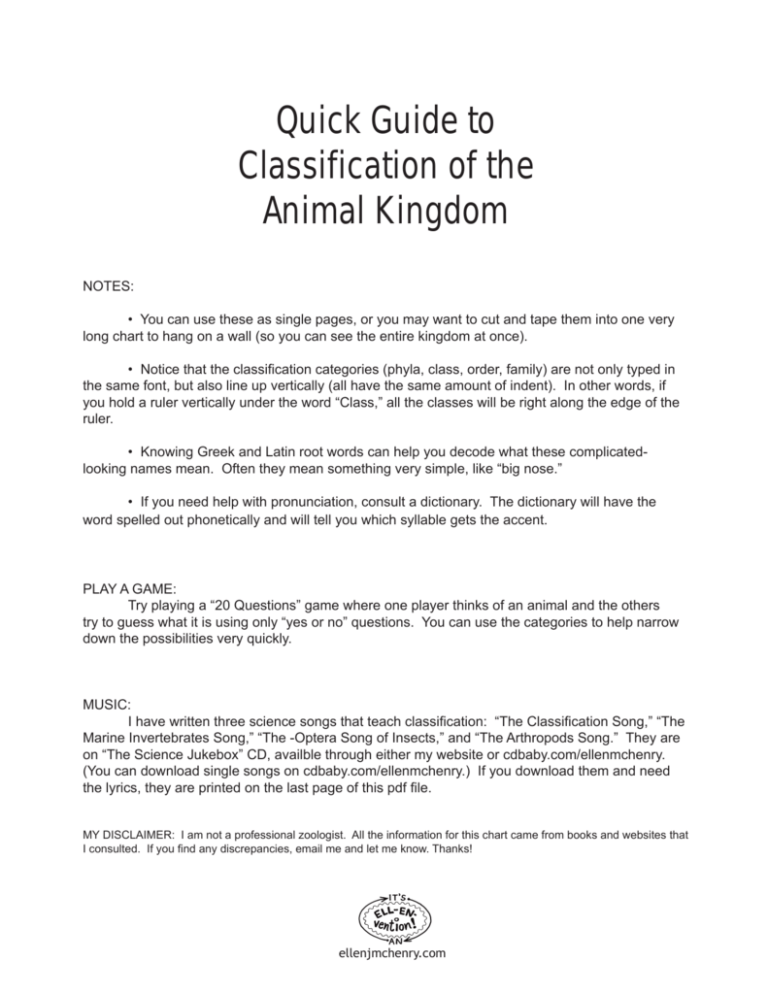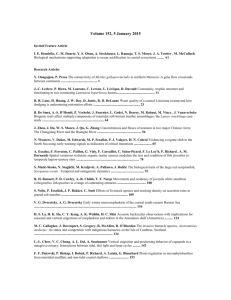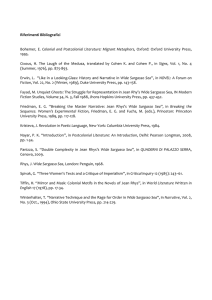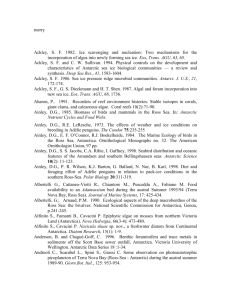Quick Guide to Classification of the Animal Kingdom
advertisement

Quick Guide to Classification of the Animal Kingdom NOTES: • You can use these as single pages, or you may want to cut and tape them into one very long chart to hang on a wall (so you can see the entire kingdom at once). • Notice that the classification categories (phyla, class, order, family) are not only typed in the same font, but also line up vertically (all have the same amount of indent). In other words, if you hold a ruler vertically under the word “Class,” all the classes will be right along the edge of the ruler. • Knowing Greek and Latin root words can help you decode what these complicatedlooking names mean. Often they mean something very simple, like “big nose.” • If you need help with pronunciation, consult a dictionary. The dictionary will have the word spelled out phonetically and will tell you which syllable gets the accent. PLAY A GAME: Try playing a “20 Questions” game where one player thinks of an animal and the others try to guess what it is using only “yes or no” questions. You can use the categories to help narrow down the possibilities very quickly. MUSIC: I have written three science songs that teach classification: “The Classification Song,” “The Marine Invertebrates Song,” “The -Optera Song of Insects,” and “The Arthropods Song.” They are on “The Science Jukebox” CD, availble through either my website or cdbaby.com/ellenmchenry. (You can download single songs on cdbaby.com/ellenmchenry.) If you download them and need the lyrics, they are printed on the last page of this pdf file. MY DISCLAIMER: I am not a professional zoologist. All the information for this chart came from books and websites that I consulted. If you find any discrepancies, email me and let me know. Thanks! ellenjmchenry.com Here are a few of the most common Latin/Greek word roots. This is not an exhaustive list, just some of the more common roots you’ll see in zoology. a amphi/ambi arthro bi brachi cephalo cervid cervix chilo/chello chiro chondro/chondra cnida coelen cteno coleo derm/derma di/diplo dicty echino equus gastro hippo hydro/hydra hymen hyper hypo iso lepido macro micro moll morph myo ortho osteo odont oto pinna platy pleuro pod/ped ptera siluri syn tachy tetra tri ura without both joint two arm head deer neck lip hand cartilage stinging nettle (a plant) (the “c” is silent; say “ni-da”) hollow comb (the “c” is silent; say “ten-o”) sheeth or scabbard (the covering for a sword) skin two net (like a fishing net) spiny horse stomach horse water membrane over under equal or same scale or scaly arge small soft shape muscle straight bone tooth ear wing or feather flat or broad side or rib foot wing a kind of fish with swift four three tail KINGDOM PHYLUM SUB-PHYLUM Class Order Family NOTE: If you would like to know the genus and species for a certain animal, you can find this information listed on the Wikipedia article about that animal (on the Internet). KINGDOM ANIMALIA ROTIFERS microscopic creatures such as philodina and rotaria NEMATODES roundworms (includes hookworms, pinworms and vinegar eels) ANNELIDS segmented worms such as the common earthworm PLATYHELMINTHES flatworms such as the planaria and the fluke PORIFERA sponges CNIDARIA (also called COELENTERATES) jellyfish, hydra, sea anemones, corals CTENOPHORES comb jelly ECHINODERMS starfish, sand dollars, sea urchins, sea lilies, sea cucumbers MOLLUSKS Cephalopods: (means “head foot”) octopus, squid, nautilus Gastropods: (means “stomach foot”) slug, snail, abalone, limpet, and others with one shell Pelecepods: (means “hatchet foot”) (also called “bi-valves”) clam, oyster, mussel ARTHROPODS Insects Coleoptera: beetles and weevils Dermaptera: earwig Dictyoptera: cockroach and mantis Diptera: flies Hemiptera: “true bugs” such as shield bug Hymenoptera: ant, bee, hornet and wasp Isoptera: termite Lepidoptera: butterflies and moths Odonata: dragonfly and damselfly Orthoptera: grasshopper and cricket Siphonaptera: flea Arachnids: spiders, ticks, scorpions, harvestmen (“granddaddy long legs”) Crustacea: crab, lobster, water flea, daphnia, copepod Chilopoda: centipedes Diplopoda: millipedes CHORDATA SUB-PHYLA CEPHALOCHORDATA the amphioxus (a strange form of sea life) TUNICATES “sea squirts” VERTEBRATES (see next page) page 1 PHYLUM SUB-PHYLUM Class Order Family VERTEBRATES Placoderms (extinct fish) Agnatha Lamprey Hagfish Chondrichthyes (cartilaginous fishes) Pleurotremata: sharks Hypotremata: rays, sawfish Osteoichthyes (bony fishes) Anguilliformes: conger eel, moray eel Atheriniformes: flying fishes Cypriniformes: goldfish, carp, piranha, minnow, electric eel Cyprinodontiformes: black molly Gadiformes: cod, whiting Gasterosteiformes: seahorse, stickleback, leafy seadragon, pipefish Perciformes: grouper, beat, mackerel, parrot fish, goby, angel fish, perch, wrasse, clownfish, remora, snapper, surgeonfish, bass, barracuda, cichlid Pleuronectiformes: sole, halibut, turbot (flat fishes) Salmoniformes: trout, salmon, viperfish Scorpaeniformes: scorpionfish Siluriformes: catfish Synbranchiformes: swamp eel Tetraodontiformes: blowfish, triggerfish, porcupine fish Amphibia Urodeles Salamandridae: salamanders and newts Anurans Ranidae: bull frog, green frog Dendrobatidae: poison dart frog Bufonidae: common toad Pipidae: Surinam toad Hylidae: European tree frog Discoglassidae: firebelly frog Reptilia Squamata (lizards and snakes) Sub-order “Sauria” (lizards) Geckonidae: gecko Chamaeleonidae: chameleon Iguanidae: iguana, lizards, anole Helodermatidae: gila monster Varanidae: monitor page 2 PHYLUM SUB-PHYLUM Class Order Family VERTEBRATES (continued) Reptilia (continued) Sub-order “Ophidia” (snakes) Colubridae: grass snake, rat snake, king snake, tree snake Viperidae: viper, adder, asp Crotalidae: rattlesnake moccasin, bushmaster Boidae: boa, anaconda, python Elapidae: spitting cobra, mamba, coral snake Hydrophidae: sea snake Chelonia (turtles) Cheloniidae: sea turtle Testudinidae: tortoise Emydidae: painted turtle Chelydridae: snapping turtle. box turtle Trionychidae: soft-shelled turtle Crocodilia (crocodiles and alligators) Alligatoridae: alligator, cayman Crocodilidae: crocodile Aves (birds) Anseriformes: duck, swan, goose Apterygiformes: kiwi Charadriiformes: gull, tern, puffin, sand piper Ciconiiformes: stork, heron, bittern, ibis, spoonbill Columbiformes: pigeon, dove Coraciiformes: hornbill, kookabura Galliformes: chicken, turkey, pheasant, quail Falconiformes: hawk, falcon, vulture Passeriformes: “perching birds” such as the blackbird, myna bird, and most common song birds we see every day Pelicaniformes: pelican, gannet, cormorant Piciiformes: toucan, woodpecker Procellariiformes: petrel, albatross Psittaciformes: “hookbills” such as the parrot, cockatiel and cockatoo Rheiformes: rhea Sphenisciformes: penguin Strigiformes: owls Struthioniformes: ostrich page 3 PHYLUM SUB-PHYLUM Class Order Family Mammalia Monotremes: (egg-laying mammals) platypus, echidna Marsupials: (have a pouch) Phalangeidae: koala, dormouse, cuscus, brush-tail opossum Peramelidae: bandicoot Macropodidae: kangaroo, pademelon Didelphidae: woolly opossum Dasyuridae: dasyure, marsupial mouse Artiodactyls: (hoofed mammals with even number of toes) Antilocapridae: pronghorn Peramelidae: antelope, gazelle, gnu, yak, goat, chamois, sheep, ibex, bison, eland, zebu, oryx, dik-dik, kudu, duiker Camelidae: camel, llama, alpaca Cervidae: muntjac, deer, moose, elk, caribou Giraffidae: giraffe, okapi Hippopotamidae: hippopotamus Moschidae: musk deer Suidae: forest hog, warthog, wild boar, pig Tayassuidae: peccary Tragulidae: chevrotain Carnivores (meat-eaters) Auluropodidae: panda Canidae: dog, fox, wolf Felidae: all cats Hyenidae: hyena, aardwolf Mustelidae: weasel, badger, ferret, otter, mink, skunk, polecat Procyonidae: coati, kinkajou, raccoon, lesser panda Ursidae: bears Vivereridae: mongoose, civet, genet, suricate, linsang Cetacea Delphinidae: orca (“killer whale”), dolphin Balaenopteridae: baleen whales Chiroptera (“hand-wings”) Megachiroptera: large bats such as flying fox, vampire bat, fruit bat Microchiroptera: small, insect-eating bats such as brown bat Dermoptera: flying lemur (not related to the true lemurs) Edentata Myrmecophagidae: giant anteater Tachyglossidae: spiny anteater page 4 PHYLUM SUB-PHYLUM Class Order Family Mammalia (continued) Hyracoidea: hyrax Insectivores: (insect-eating mammals) Soricidae: pygmy shrew Chrysochloridae: golden mole Erinaceidae: hedgehog Solenodontidae: otter shrew Solenodontidae: solendon Lagomorphs Leporidae: rabbit Perissodactyls (hoofed mammals with an odd number of toes) Equidae: horse, donkey, zebra, Tapiridae: tapir Rhinocerotidae: rhinoceros Philodota: pangolin Pinnipeds (“wing-foots”) Otariidae: sea lion, fur seal Phocidae: seal Odobentidae: walrus Primates Ceropithecidae: baboon, macaque, pata, moustached monkey, Rhesus monkey Lemuridae: lemurs Daubentoniidae: aye-aye Cebidae: squirrel monkey, spider monkey, saki, capuchin, howler monkey Galagidae: bushbaby Callithricidae: tamarin, marmoset Hylobatidae: gibbon Pongidae: orangutan, gorilla, chimpanzee Colobidae: proboscis monkey Tarsiidae: tarsier Lorisidae: loris Tupaiidae: common tree shrew Proboscidea (uses nose for feeding) Elephantidae: elephant (and extinct mammoth) Rodents Cricetidae: hamster, gerbil, red-nosed mouse, lemming, vole Sciuridae: squirrel, flying squirrel, prairie dog, marmot, woodchuck, chipmunk Chinchillidae: chinchilla Caviidae: guinea pig, mara (Patagonian hare) page 4 PHYLUM SUB-PHYLUM Class Order Family Rodents (continued) Muridae: mouse, rat Hydrochoeridae: capybara Hystricidae: porcupine Castoridae: beaver Myomorpha: dormouse Gliridae: hazel dormouse, golden dormouse Erethizontidae: tree porcupine Dasyproctidae: agouti Sirenia Trichechidae: manatee Dugongidae: dugong Tubulidentata Orycteropidae: aardvark page 5






